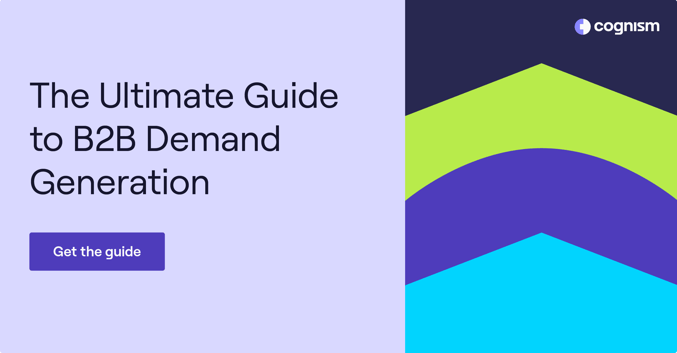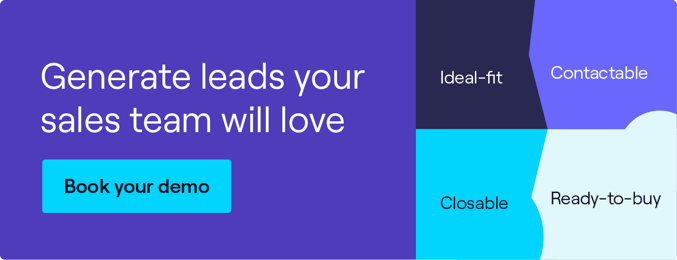What Is Demand Generation in Marketing? [+Strategies]
Demand generation is the entire range of B2B marketing and sales initiatives that generate interest in your company’s product or service.
But it's not just about discovering prospects that already exist.
It’s about stimulating interest in people who don’t know anything about you. The most effective demand generation strategies concentrate on the problems that prospects face and then supply solutions.
In this article, you'll find:
- Demand generation definition
- Best ways of creating demand
- How to build demand gen strategy and measure its success
What is demand generation marketing?
In marketing, demand generation is the process of increasing awareness and demand for your product or service. The goal is to expand your audience, build authority, and generate interest around your brand that results in high-quality leads
Demand gen covers a wide range of activities that start before you have even identified a prospect. They don’t end once the prospect has converted and signed on as a customer.
For an effective demand generation, you need alignment and transparency between your sales and marketing functions, with both teams being able to identify gaps or blockages in the process.
Learn more about building a B2B lead generation strategy from the video below.
Demand generation vs. lead gen
While demand generation aims at attracting new visitors to your brand and building your reputation as n expert in the industry, lead generation focuses on converting the newly attracted prospects.
What are the best demand generation strategies?
A strong demand generation program produces engaging, high-quality, and authoritative content that drives your ideal customers. Let's take a look at the top lead generation tactics you can include in your B2B marketing strategy.
1. Content marketing
According to the 2021 B2B Buyers Survey, decision-makers, influencers, and researchers agree that "content that spoke directly to and demonstrated expertise around the needs of the organization’s specific industry" influenced their decision.
There are many types of content you could choose to generate demand for your business. For example:
- Blogs – articles on your website that educate your audience and help you get found on Google.
- Videos – YouTube content that explores your product or topics relevant to your target audience.
- eBooks – long-form textbooks or whitepapers that you can give away on your site, either gated or ungated.
- Podcasts/webinars – deep dives into specific industry themes or product features, normally with external guest speakers.
- Industry insights – inviting industry influencers to contribute to your content and promote it to their networks.
Whatever mediums (e.g. an email signature) you choose to create content on, make sure your content answers the questions your ideal customers are asking.
Why don't you discover how to use content marketing to close deals with Cognism's Global Head of Demand Generation, Liam Bartholomew. Press ▶️ to watch.
2. Account based marketing (ABM)
Running account based marketing campaigns is a great strategy for B2B demand generation because it focuses on a narrowly-defined audience. ITSMA Survey found that companies using ABM saw an 84% rise in reputation score and a 74% improvement in customer relationships.
This approach lets you drive demand with specific companies and individuals which delivers better results down the sales funnel. You can run ABM campaigns, email marketing, LinkedIn ads, or direct email. They are cost-effective ways to get into your ideal customer’s inbox.
Here are some of the lead gen best practices you should follow while using this strategy:
- Use your content and account based marketing data to build an email list.
- Segment your list into precisely-targeted groups.
- Then use email automation software to initiate sequences of emails that keep your prospects thinking about you.
Ensure you track the responses to your emails and always look for ways to improve results. Check out top examples of demand generation with email marketing campaigns.
3. Paid advertising
Paying to be where your ideal customers are spending their time online is one of the fastest ways of generating demand.
You can promote your content with pay-per-click (PPC) ads that place you at the top of Google when someone searches for your chosen keyword. Or you can pay to show up in your ideal customers’ social media feeds.
Platforms like Google and Facebook offer comprehensive analytics on the back end, so you can easily see what’s working and what isn’t.
Sign up for the best demand gen insights, delivered straight to your inbox! 📥
Tip! Demand generation channels are similar to lead generation strategies. The difference between them is the goal and the result.
Tips for better demand generation campaigns
Demand generation covers such a wide range of activities that there’s no one-size-fits-all. But here are three tips for successful demand gen programs.
1. Know your customer
Create an Ideal Customer Profile (ICP). This will be the north star for all your demand generation strategies. Make it as narrow as possible, so you can craft a message that speaks to their pain points.
2. Track everything
Measure as much as you can and reflect on the results you get. Double down on what works and cast off what doesn’t. Tech is here to help you with demand generation reports.
3. Have a great site
Your website will be your ICP’s first port of call after consuming your content. Make sure it shows you and your brand in the best light.
Demand generation metrics
Every organization will focus on slightly different marketing metrics. Here are three KPIs you can track to measure demand gen success:
1. Cost per acquisition (CPA)
The average cost of winning one paying customer. You will have a CPA for your entire demand gen operation, but you can also narrow it down to get a CPA for individual lead sources or activities.
2. Customer lifetime value (CLV)
The average net profit one customer will bring into the company during their time with you. Raising the CLV is where your sales function and customer success team can make a difference.
3. Demand gen cycle length
The average time from identifying a lead to turning them into a customer. The goal is to shorten this time as much as possible.
Who does demand generation?
Demand generation activities are usually executed by your marketing or sales teams, depending on where each activity sits in your sales strategy.
The demand generation manager's job is about researching your market, creating and promoting your content, and fine-tuning customer experience with your brand.
However, other activities such as lead nurturing and customer retention will lie with your sales (or Customer Success) teams.
That's why demand generation specialists need to use their skills and strategic knowledge to find ways to align with other teams across your organization to help you conquer new markets.
Demand generation software
There are hundreds of demand generation tools to help you make your campaign work better. To help you get your head around them, we curated the following lists of tools:
- The ultimate B2B marketing tech stack
- The ultimate B2B sales tech stack
- B2B marketing software
- The best B2B sales tools
Looking for a more practical guide to demand gen?
Download Cognism's revenue-focused guide to demand marketing today. 📖
How to use Cognism for demand gen?
Once you’ve created your ICP, you need a comprehensive and accurate list of people that matches that profile. If you don’t, you won’t be able to build an audience, and you could be wasting your time trying to convert leads that don’t exist anymore.
Cognism Prospector allows you to create lists that exactly match your ICP, so all you need to concentrate on is crafting content that speaks to them. Then, use Prospector to launch your demand gen campaigns. The platform guarantees some of the highest email deliverability rates in the B2B industry.
Book your demo with Cognism
Why read an essay about Cognism’s demand gen capabilities, when you could see the tool for yourself?
It only takes a second to register - click 👇 to get started.





